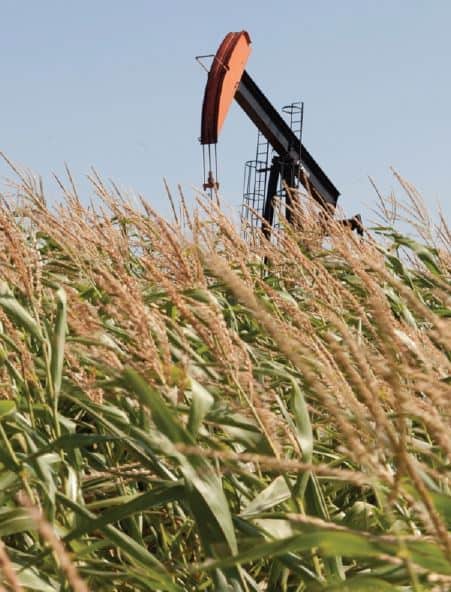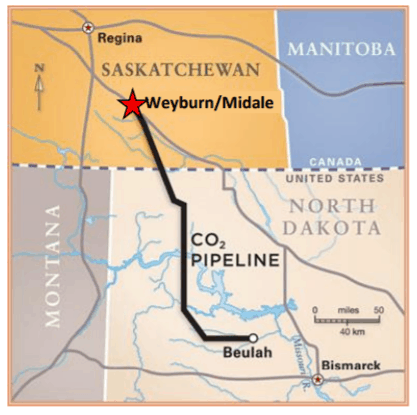The regulatory authority of the U.S. Environmental Protection Agency (EPA) applies only to the United States, so the mandate of Underground Injection Control (UIC) regulations ends at the American border. However, enhanced oil recovery (EOR) techniques and research into their efficacy and best practices are widespread and growing in the United States’ northern neighbor. One of the world’s largest combined EOR and carbon capture, utilization and storage (CCUS) projects is in Saskatchewan, Canada.1Brown, K., Whittaker, S., Wilson, M., Srisang, W., Smithson, H., & Tontiwachwuthikul, P. (2017). The history and development of the IEA GHG Weyburn-Midale CO2 Monitoring and Storage Project in Saskatchewan, Canada (the world’s largest CO2 for EOR and CCS program). Petroleum, 3(1), 3-9.

Operations at the neighboring Weyburn and Midale oil fields began in the 1950s and primary oil production continued until the 1970s when production began to decline due to depressurization of the reservoir. Operators attempted to increase production with vertical infill drilling through the late 1980s and early 1990s before transitioning to horizontal wells and water flooding during the early 1990s. Then in the year 2000, operators began CO2-EOR.2Brown, K., Whittaker, S., Wilson, M., Srisang, W., Smithson, H., & Tontiwachwuthikul, P. (2017). The history and development of the IEA GHG Weyburn-Midale CO2 Monitoring and Storage Project in Saskatchewan, Canada (the world’s largest CO2 for EOR and CCS program). Petroleum, 3(1), 3-9.
Anthropogenic CO2 Used for EOR Activities
Industrial-grade CO2 travels 205 miles (330 km) by pipeline from the Great Plains Synfuels Plant in Beulah, North Dakota, to the Weyburn and Midale oil fields for EOR. Since October 2014, CO2 also began coming from SaskPower’s coal-fired Boundary Dam Power Station.3University of North Dakota Energy & Environmental Research Center. (n.d.). Weyburn–Midale CO2 Project. Retrieved November 3, 2020, from https://undeerc.org/pcor/co2sequestrationprojects/Weyburn.aspx

The behavior of the CO2 accumulating in the underground oil-producing zones during the commercial EOR operation was the focus of the IEA Greenhouse Gas R&D Programme Weyburn–Midale CO2 Monitoring and Storage Project, an 11-year, $85 million scientific assessment completed in 2011. The assessment program was funded by numerous government and industry sources, including the Department of Natural Resources Canada and the U.S. Department of Energy.4University of North Dakota Energy & Environmental Research Center. (n.d.). Weyburn–Midale CO2 Project. Retrieved November 3, 2020, from https://undeerc.org/pcor/co2sequestrationprojects/Weyburn.aspx
The geology of the Weyburn field sits at the focus of many decades of academic research and is thus well understood. The reservoir’s upper seal and all nearby faults have been modeled extensively. Simulation indicates EOR operations may store up to 23 Mt of CO2 into the formation by 2033.5Law, D., Huang, S., Freitag, N., Perkins, E., Wassmuth, F., Dunbar, B., & Asghari, K. 2004. Theme 3: CO2 storage capacity and distribution predictions and the application of economic limits. IEAGHG Weyburn CO2 Monitoring and Storage Project Summary Report 2000-2004, 149. In the event that storage projects continue following the cessation of EOR operations, the target formation is still expected to hold up to 55 Mt of CO2 on a timescale of 5,000 years based on models and analyses.6Whittaker, S. G. (2005). Geological characterization of the Weyburn Field for geological storage of CO2: Summary of Phase I results of the IEA GHG Weyburn CO2 Monitoring and Storage Project. Summary of Investigations, 1(6). Retrieved November 8, 2020, from http://publications.gov.sk.ca/documents/310/88854-Whittaker_2005vol1.pdf.
There was a significant controversy surrounding the Weyburn-Midale CO2 Monitoring and Storage Project. In January, 2011 landowners made allegations that CO2 had leaked from the approved CO2-EOR area of the Weyburn Unit near Goodwater, Saskatchewan and impacted their land.7Romanak, K., Sherk, G. W., Hovorka, S., & Yang, C. (2013). Assessment of alleged CO2 leakage at the Kerr farm using a simple process-based soil gas technique: Implications for carbon capture, utilization, and storage (CCUS) monitoring. Energy Procedia, 37, 4242-4248. The couple commissioned consultants to investigate algal blooms and bubbling ponds on their property.8Weber, B. & J. Graham. (2011, January 11). Land fizzing like soda pop: farmer says CO2 injected underground is leaking. The Canadian Press. Retrieved November 8, 2020, from http://www.ecoglobe.ch/climate/e/ccsl1110.htm The report indicated a potential link between high levels of CO2 dissolved in the soil and the Weyburn CO2 injections.
The Petroleum Technology Research Center, which at the time coordinated the Weyburn-Midale CO2 Monitoring and Storage Project, published their own evidence to the contrary, and the International Performance Assessment Center for the Geologic Storage of Carbon Dioxide brought in researchers from The University of Texas at Austin Bureau of Economic Geology for an independent assessment. In the next topic page you will see a profile of the Bureau of Economic Geology’s lead scientist on the project, as well as a case study video on the surface monitoring aspects of the investigation.